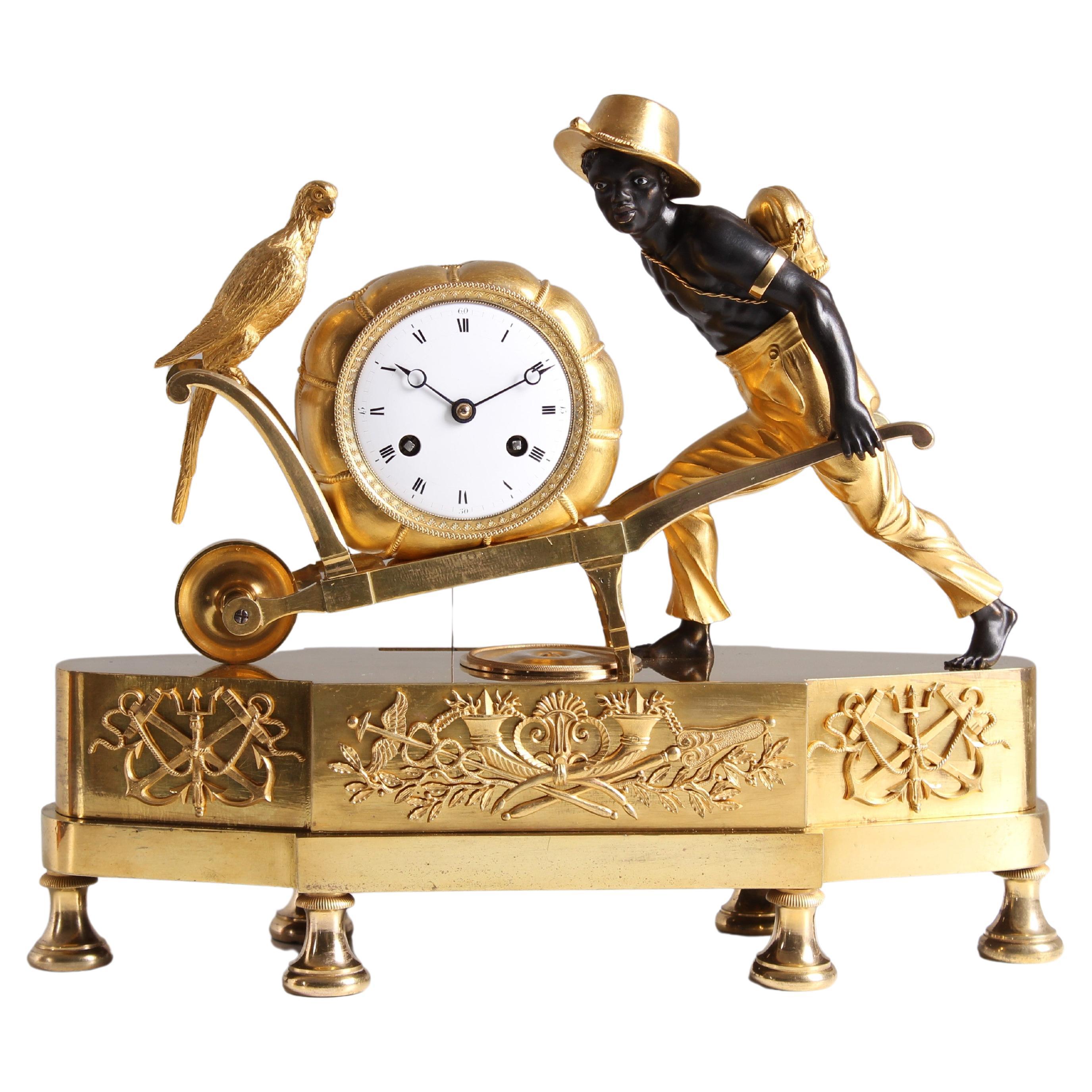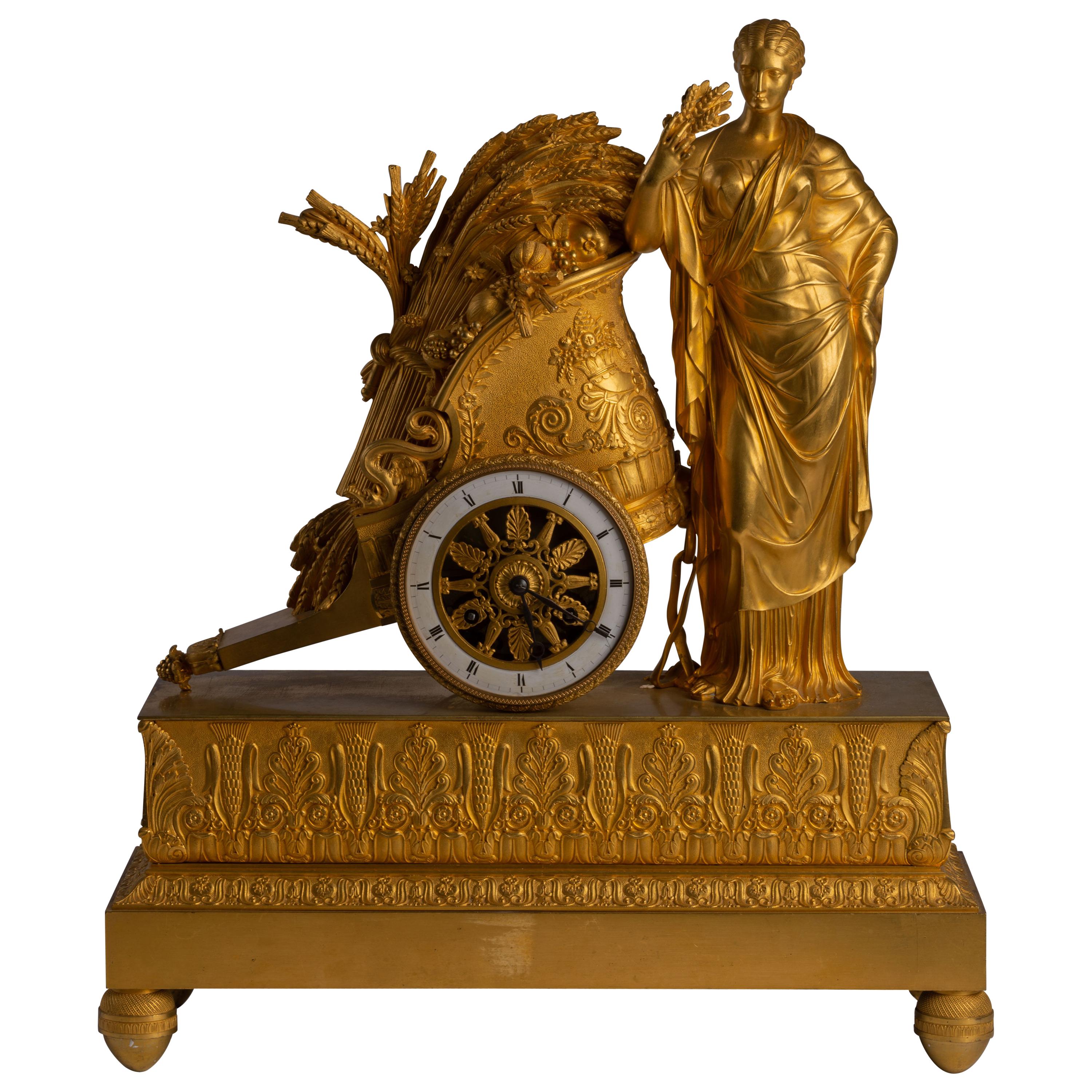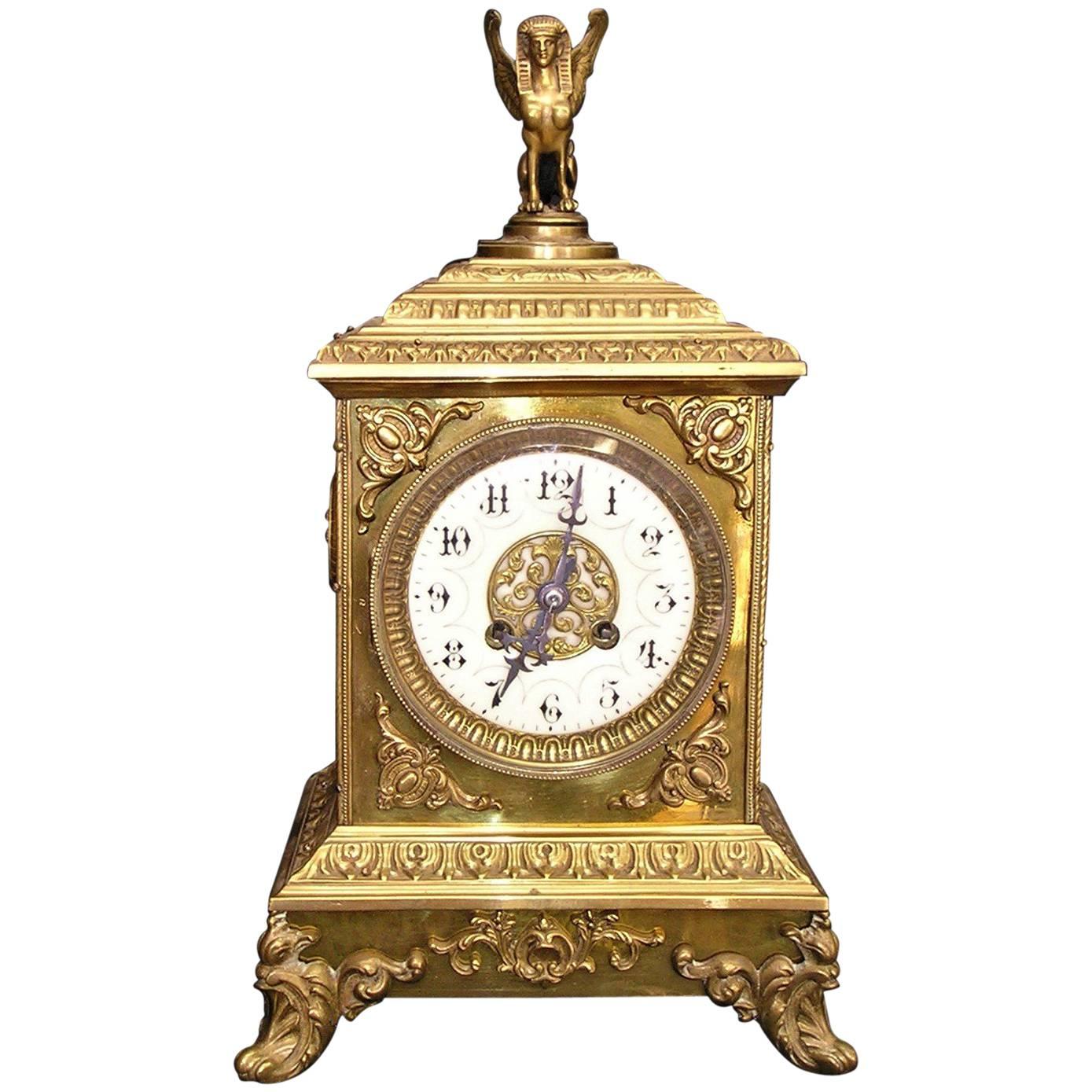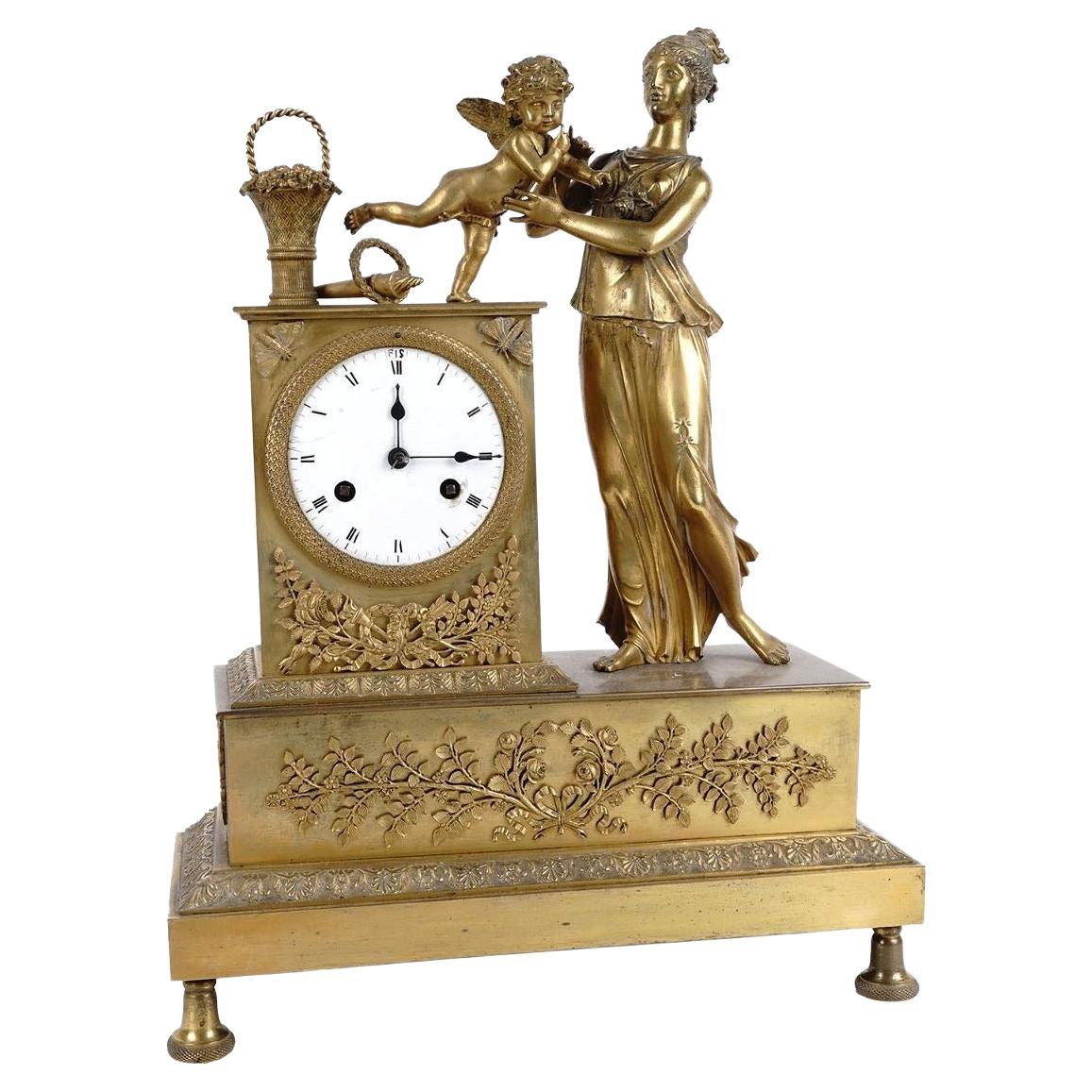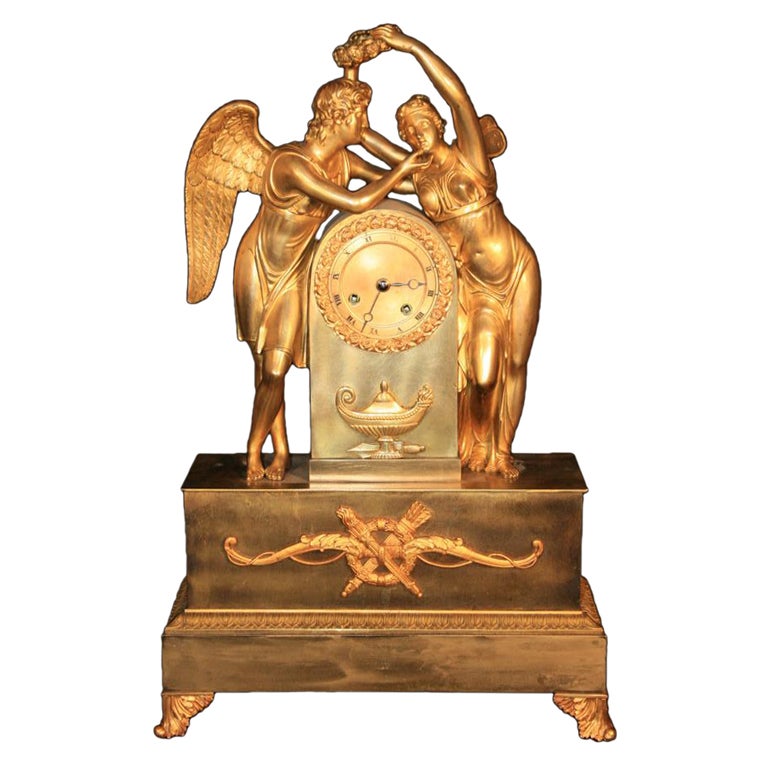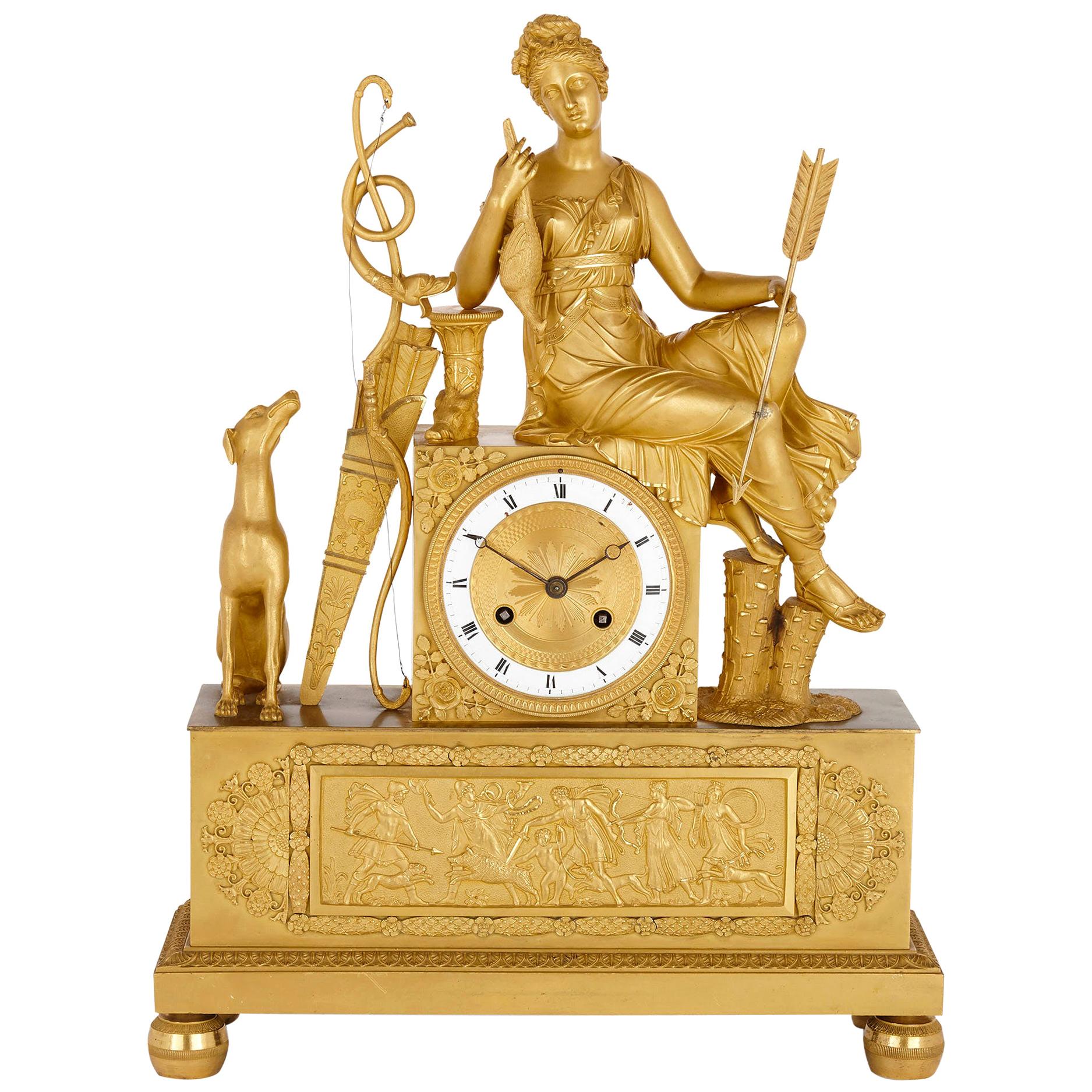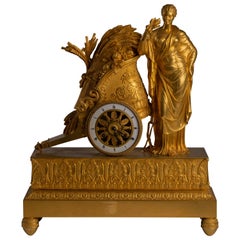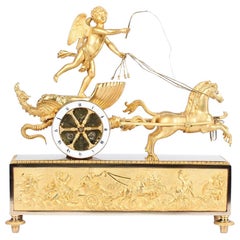
Empire Mantel Clock, Char de l'Amour, Cupid, Firegilt Bronze, France, circa 1810
View Similar Items
Want more images or videos?
Request additional images or videos from the seller
1 of 9
Empire Mantel Clock, Char de l'Amour, Cupid, Firegilt Bronze, France, circa 1810
About the Item
- Dimensions:Height: 18.51 in (47 cm)Width: 18.9 in (48 cm)Depth: 5.91 in (15 cm)
- Style:Empire (Of the Period)
- Materials and Techniques:
- Place of Origin:
- Period:
- Date of Manufacture:1810
- Condition:Wear consistent with age and use. Restored condition. Movement and case completely cleaned. The clock runs perfectly reliable.
- Seller Location:Greven, DE
- Reference Number:1stDibs: LU5419220470162
About the Seller
5.0
Platinum Seller
These expertly vetted sellers are 1stDibs' most experienced sellers and are rated highest by our customers.
Established in 2014
1stDibs seller since 2020
112 sales on 1stDibs
More From This SellerView All
- Early 19th Century Mantel Clock, Firegilt Bronze, Paris circa 1810Located in Greven, DEVery rare "Au Bon Sauvage" mantel clock France Fire-gilt and patinated bronze Empire around 1810 Dimensions: H x W x D: 34 x 41 x 13 cm Description: Extremely rare French bronze m...Category
Antique Early 19th Century French Empire Mantel Clocks
MaterialsBronze
- Early 19th Century Pendule Portefaix, Firegilt Bronze, Empire, Circa 1810Located in Greven, DEPendule Portefaix France (Toulouse) bronze, enamel Empire around 1810 Dimensions: H x W x D: 36 x 28 x 11 cm Description: Beautiful fire-gilded and patinated bronze pendulum from the early 19th century. Depicted is a young man carrying a large cotton package on his back. In his right hand he holds a letter, with his left he is leaning on a bamboo stick. His tobacco pipe is stuck in his hat string, and he carries his water bottle on his belt. In interesting color contrast is not only the fire gilding to the deep black patinated bronze, but also particularly striking are the white glass eyes. The ciselleur has managed to make materials tangible through different surface treatments. For example, the skin is discreetly hatched differently from the cotton fabric of the trousers; the bottle, bracelets and pannier are polished in gold. The proportions of the figure are perfectly struck, and the drapery on the trousers emphasizes the dynamic movement. The heart of the watch is an 8-day movement with date from the Prevost Freres workshop, which is attested in Toulouse from 1809. The Breguet hands are blued, the pendulum is suspended on a thread, typical of the time. The clock strikes a bell on the half and full hour. Fun Facts: The depiction of Le Portefaix is by Parisian bronze caster Jean-André Reiche, who registered his artistic design in Paris in 1808. In addition to the depiction of the cotton picker, there are numerous other pendulums that deal with the theme of colonization. Other themes from the "new world" were also treated artistically - exotic animals and plants - butterflies, birds of paradise, tobacco and spices.... Today's viewers react to the objects with both fascination and irritation. Enthusiastic on the one hand by the obvious quality of the detailed bronzes, on the other hand distanced-cautious because of the possible discrimination that is suspected behind it. The ambivalence of this feeling motivates the search for the conditions of origin of these pendulums. Europeans found their new ideal of the natural man mainly in fictional and realistic travelogues about the Indians of North America...Category
Antique Early 19th Century French Empire Mantel Clocks
MaterialsBronze
- French Empire Ormulu Bronze Mantel Clock, Lepaute, Thomire, Paris, circa 1815Located in Greven, DEOrmulu pendule with depiction of friendship and love Paris (Lepaute, Thomire) fire-gilt bronze Empire around 1815 Dimensions: H x W x D: 44 x 36 x 13 cm French pendulum movement with eight days duration. Thread suspension and lock disc striking movement with strike on bell on the half and full hour. White enamel dial with Roman hour numerals and Breguet hands. Signature: LePaute & Fils / Hrl. du Roi (Pierre-Basile Lepaute (1750 - 1843) with his son Pierre-Michel Lepaute (1785-1849); from 1811 in joint workshop). Description: The extremely high quality pendulum shown here takes up a profound theme: Friendship, which combines with love and can thereby outlast time and death. As it is typical for the epoch of classicism, personifications and symbols are taken from the fund of ancient mythology and art and then developed further. The main figure is a young woman in an antique, girded garment, standing barefoot and with crossed legs next to an altar, on which she is leaning with her left elbow. She gracefully bows her head towards a tempestuously approaching Cupid, grasps his right hand with her left and draws him to her bosom, the seat of the heart. The delicate ambivalence of flying towards and being held culminates in the trustingly intimate look that the two cast at each other. The young woman personifies friendship, the winged Cupid love. As a sign of their intimate connection, two burning hearts appear on the altar next to the two, framed by the puffed scarf, which are closely bound together by a chain of flowers. Next to them, on the altar slab, one can see an erected book with the title "Amitie" (French: amitie, friendship). Supporting the book is a pomegranate held by a ring of pomegranate flowers. The bursting seeds spill out of the cracked skin. Since ancient times, the pomegranate and its blossoms have been dedicated to the goddess Persephone, symbolizing the underworld and death, but also life and fertility. The myrtle interwoven in the pomegranate flower wreath of "friendship" also has a far-reaching symbolic power: the plant was dedicated to the goddess Aphrodite, stands for virginity, and was and is therefore obligatory in the bridal wreath...Category
Antique Early 19th Century French Empire Mantel Clocks
MaterialsBronze, Enamel
- 19th French Empire Mantel Clock, Pendule, Mercury, Gilded Bronze, circa 1815Located in Greven, DE19th century French pendule, mantel clock - Mercury the messenger of the gods France Bronze gilded Empire around 1815 Dimensions: H x W x D: 37 x 30 x 10 cm Description: French Empire...Category
Antique Early 19th Century French Empire Mantel Clocks
MaterialsBronze
$6,667 Sale Price30% Off - Empire Mantel Clock - La Bibliotheque, Ormolu, France, Paris, circa 1820By Le RoiLocated in Greven, DEMantel Clock - La Bibliotheque - In the study room Paris fire-gilt bronze, enamel Empire around 1820 Dimensions: H x W x D: 38 x 28 x 19 cm Description: Scenery mounted on an oval...Category
Antique Early 19th Century French Empire Mantel Clocks
MaterialsBronze
- Early 19th Century Ormolu Mantel Clock, Atala freeing Chactas, Paris, circa 1810Located in Greven, DEMantel Clock "Atala and Chactas" Paris Bronze (fire-gilt and patinated), enamel Empire around 1810 Dimensions: H x W x D: 40 x 32 x 11 cm Description: Very rare and extremely high quality French mantel clock, so-called Pendule Au Bon Sauvage. Depicted are scenes from the love story "Atala or the love of two savages in the desert" written by Francois René Vicomte de Chateaubriand in 1801. At the beginning of the 19th century, this was probably the most famous love story in Europe, but today it has been forgotten. The story, set in present-day Louisiana (USA), is roughly rewritten about the forbidden love between Chactas, a young Indian, and Atala, the beautiful daughter of a Spaniard. Chactas is captured in a battle between two Indian tribes, chained to a palm tree and is to be sacrificed. Atala wants to save his life and convert him to Christianity. She unties him from the palm tree at night and they flee together into the wilderness of North America. Their love for each other grows stronger and stronger and they have prospects for a future together. The story takes a tragic turn when Atala, who must remain a virgin due to a vow made by her mother, can no longer withstand the conflict of her feelings and commits suicide. The main group of characters thus shows Chacta's liberation through Atala. Atala is leaning against a pile of logs. The animal fur thrown over the logs and the weapons leaning against the stack on the right give the impression of a night camp. The bronze is of rarely beautiful quality, finely chiselled and makes the scene appear very lively. The contrast of fire-gilded and patinated bronze adds tension to the composition. In the base we see the Entombment as the end of the tragic love story. This bronze work is also very detailed, the interplay of bright and matt gilding makes the flat relief appear much deeper than it is. The depiction of the mantel clock presented here shows that the exotic was only known from stories and that the bronzier had his own ideas about the appearance of this distant world. The Indian, for example, has very European facial features and his skin was not black in reality, of course. The palm tree was also certainly not found in the North American wilderness. The heart of the clock is a French pendulum movement, integrated into the wooden pile, with an eight-day power reserve and a lock plate striking a bell on the half and full hour. The pendulum is suspended on a thread, typical of the period. The classically shaped hands, so-called Breguet hands, are also typical of the time. The enamelled dial has black Roman hour numerals, Arabic quarter hours and bears the signature: Le Roy hr. de Madame A PARIS. Interesting facts: The period from 1795 to about 1815 saw the creation of probably the most spectacular group of bronzes: The "Au bon Sauvage" pendulums - depictions of the "Noble Savage". Today's viewers react to these objects with both fascination and irritation. Enthusiastic on the one hand about the obvious quality of the detailed bronzes and the allure of the exotic, on the other hand distanced and cautious because of the possible discrimination that is suspected behind them. The ambivalence of this feeling motivates the search for the conditions of origin of these pendulums. Europeans found their new ideal of the natural man primarily in fictional and realistic travelogues about the Indians of North America...Category
Antique Early 19th Century French Empire Mantel Clocks
MaterialsOrmolu
You May Also Like
- c.1810 French Ormolu Mantle Clock, ‘La Delivrance de l’Amour’Located in Greenlawn, NYMaker: Dubuc Aine à Paris Case: The well-cast and finished ormolu is surmounted by a female figure leaning over and opening the top door of cage containing a putti. Flanking t...Category
Antique Early 19th Century French Empire Mantel Clocks
MaterialsOrmolu
- French Empire Gilt Bronze Mantel Clock with Venus and CupidLocated in London, GBFrench Empire gilt bronze mantel clock with Venus and Cupid French, early 19th Century Measures: Height 53cm, width 37.5cm, depth 13.5cm This fine Empire period mantel clock is crafted from gilt bronze. The clock includes a sculptural surmount of Venus accompanied by Cupid. Venus sits atop the square clock...Category
Antique Early 19th Century French Empire Mantel Clocks
MaterialsBronze, Ormolu
- Empire Ormolu Mantel Clock 'Pendule au char'Located in Kittery Point, METhe rectangular base decorated with a wheat and foliate frieze and raised on four ball feet, the goddess of agriculture Ceres standing while leaning against a Roman chariot with harv...Category
Antique Early 19th Century French Empire Mantel Clocks
MaterialsBronze
- French Empire Style Bronze Mantel ClockLocated in Hamilton, OntarioFrench Empire style bronze mantel clock.Category
Antique 19th Century French Empire Mantel Clocks
MaterialsBrass, Bronze
$5,000 Sale Price20% Off - French Empire Mantel Clock of Two Cupids Signed CoeurLocated in London, GBexceptionally rare French Empire mantel clock of two cupids signed Coeur fils Rue St Honore No 140 a Paris. This small mantel clock of exceptional q...Category
Antique 1810s French Empire Mantel Clocks
MaterialsBronze, Ormolu
- French Empire Ormolu Bronze Mantel ClockLocated in New York, NYAntique (early 19th century) French ormolu bronze mantel clock in the Empire style depicting neoclassical maiden with child.Category
Antique 19th Century French Empire Mantel Clocks
MaterialsBronze
Recently Viewed
View AllMore Ways To Browse
Antique Char
French Gilt Bronze Clocks Cupid
Steer Mount
Antique Horse Clock Clocks
Horse Clocks Antique
Antique Clock Horse
Sculptural Bas Relief
Antique Clock With Horse
Horse French Clock
Mercury Pendulum Clock
Mercury Pendulum
Apollo Box
Apollo 15
Antique Clock Mercury Pendulum
Apollo Head
Antique Harden Furniture
Bronze Speed
Antique Fire Call Box

